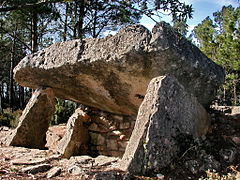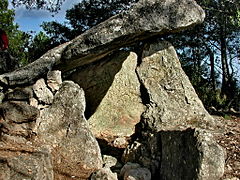Dolmen of the Adriatic
The four relatively uniformly designed dolmens of the Adriatic are north of Brignoles and the A8 road, in the Var department in Provence in France . In France, dolmen is the generic term for megalithic structures of all kinds (see: French nomenclature ).
Dolmen 1
The dolmen is located in a north-south oriented, oval hill of about 10.0 × 8.0 m. The chamber, bounded in the north and south by coarse drywall, is slightly rectangular (1.95 m long and 1.7 m wide). A threshold stone separates the chamber from the 1.62 m long, 0.80 m wide corridor, which is delimited by two side plates. The dolmen was probably tilted by an earthquake, and the massive capstone rests at the ends on two of the three once three supporting stones and on the sides of the tumulus.
Archaeological excavations under the direction of Georges Bérard have shown that the dolmen was visited over a long period of time. The oldest shift was disrupted by looting. Burned bones were found under a pavement made of small stones. The grave goods consisted of bauxite - and steatite beads , rock crystal, bone pendants, shells, some arrowheads from flint and a bracelet made of bronze . The results support the assumption that the dolmen was in use from the Chalcolithic to the Bronze Age .
- Dolmen of Adrets 1
Dolmen 2
The small dolmen 2 was discovered and excavated in 1962 by G. Berard in 1962 and restored in 1992 by Helen Barge. The tumulus with a diameter of about 7.0 m, consists of stones that seem to have been located within a double ring wall. The square chamber is 1.3 m long and opens to the west. It is bounded on the north and south sides by dry stone walls. A corridor made of dry masonry forms the entrance, which ends at a threshold stone that separates the rooms. G. Berard found the highest orthostat built in the southwest to the right of the entrance broken and with traces of hammer blows. The capstone is missing and the end stone has broken.
The excavations revealed burnt debris that was protected by plates and a pile of pebbles. The grave goods consisted of an arrowhead made of flint, some ceramic fragments and, above all, decorative disc beads made of limestone or soapstone , pendants made of shells and grandeln and a pierced boar tusk .
- Dolmens from Adrets 2 to 4
Dolmen 3
Dolmen 3 was discovered and excavated in 1962 by G. Berard in 1962 and restored in 1992 by Helen Barge. It consists of a rectangular chamber (about 4.0 m long and 2.0 m wide) that opens to the west. It lies in a tumulus made of loose stones with a diameter of about 6.0 meters and a maximum height of 0.6 m. The north and south walls of the chamber and the 0.90 m long and 0.78 m wide corridor are made of dry stone. The broken end stone and the megaliths at the entrance consist of broken menhirs, the cap stone is missing,
The chamber contained calcined human bones obtained from up to 30 individuals. The grave goods consisted mainly of jewelry that was dated to the Chalcolithic.
Dolmen 4
Dolmen 4 was discovered in 1962 by G. Berard in 1962 and excavated by Ph. Amlet. Its tumulus has a diameter of about 10.0 m. The slightly trapezoidal chamber measures 1.6 × 1.5 m and opens to the west. The corridor ends with threshold stones arranged in an arch. The north and south walls of the chamber and the corridor are bounded by dry masonry. Only one pillar of the megaliths has been preserved in situ to the left of the entrance . A large relocated stone lies next to the facility.
Although modern looting has destroyed the layers, remains (decorative elements and ceramics) were found that date the burials to the bell-cup culture .
The four dolmens have been protected as a monument historique since 1988 .
See also
literature
- Jean Courtin: Le neolithique de la Provence. (= Mémoires de la Société préhistorique française. Volume 11). Klincksieck, Paris 1974
- Hélène Barge, Eric Mahieu: Les Mégalithes du Var - 27 itinéraires de découverte. Actilia Multimédia, 2005 ISBN 2-915097-02-X
Web links
- Entry no.PA00081552 in the Base Mérimée of the French Ministry of Culture (French)
- Entry no.PA00081553 in the Base Mérimée of the French Ministry of Culture (French)
- Entry no.PA00081554 in the Base Mérimée of the French Ministry of Culture (French)
Coordinates: 43 ° 25 ′ 38.1 ″ N , 6 ° 3 ′ 35 ″ E







